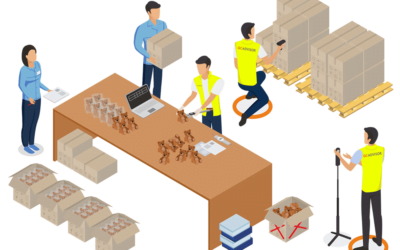Importing consumer goods from China and other Asian countries has increased dramatically over the last 20 years and has become more accessible.
Retailers, distributors, and more recently e-commerce entrepreneurs from all over the world have started dealing directly with their product manufacturers in Asia with little or no local staff to manage their supply chain on the ground.
This fast-changing environment has led to new opportunities, such as direct online contact with factories and more affordable pricing. These opportunities however come with new risks for importers, at the expense of the end-users satisfaction with the products. Scams, delivery delays, poor product quality, lack of compliance to safety & regulations are some of the issues faced.
In this context, using a reliable third part inspection company on the ground is a necessity, and knowing how to manage the local partner is the key to a successful import project.
Based on several years of experience in the Third Party Quality Control (3PQC) industry in Asia, working with hundreds of importers from all over the world, here are some best practices which I would recommend to consider if you are dealing with an inspection company in Asia, especially in China.
Step 1 – Do a proper due-diligence
Selecting the right inspection company should not only be based on price, and it’s important to investigate further about the company to make sure they’re the right partner for you. These are the few items to consider:
- The company: Are they a licensed company? Are they independent or part of a bigger organization? Is there any conflict of interest in what they do (Sourcing vs Quality Control for example).
- Staff and Product knowledge: Do they have experience in products similar the one you intend to inspect with them. Ask to see a few sample reports and related inspection criteria sheets or checklists for your product category.
- Do they have experts in the product type that you are sourcing? For instance if you are planning to inspect toys, it’s worth checking if they have engineers with experience in the safety standards that apply to your country?
- Impartiality & Integrity: Do they have a good code of conduct, and do they have processes in place to guarantee their inspectors’ impartiality and integrity?
- Performance Track records: Who are the clients they are working with and what is the background of their Managers.
Step 2 – Having a clear agreement
It is important to have an agreement on how you will work together with your 3PQC. Agreements usually include clear pricing, and workload rules. They also include:
- Inspection booking process: you need to be clear on how to book inspections with your provider
- report delivery conditions and deadlines: For example, Inspection Day before 10PM local time.
- Cancellation and postponement deadlines, rules and fees if any.
- Liability policy. Some inspections companies might offer up to 5 to 10 times the price of service in case of issues not detected and their responsibility is proven.
- For larger clients, conditions might also include dedicated personnel (direct contact at the 3PQC, e.g. coordinator, supervisor or inspectors).
Other conditions can also be agreed with your 3PQC on specific processes to strengthen integrity, such as anti-bribery agreements.
Step 3 – Defining your inspection scope
A clear inspection scope must be defined for each product and inspection type. It is a very important aspect of your relationship with the 3PQC and it is key to preempt non-conformities at an early stage of the process so you don’t face issues with your end-users.
Usually professional 3PQC players will already have their own inspection scope established by product category, however it’s worth customizing it for every of your product category to detect more complex (“tricky”) or specific issues.
Make sure to cover all the important checkpoints to control your product quality and the sampling plan of each checkpoint, especially those linked to functionality and safety and which may have a direct impact on the user experience. You also want to prioritize checking for defects that appeared in previous orders. A way to optimize your inspection scope (and thus reduce the cost of your inspection) is to exclude the checks on what has already been controlled and the ones that present (minor
Finally, to become more efficient with your inspection scope, it is recommended to review its accuracy on a regular basis and adapt it based on the issues found and on customers feedback.
Step 4 – Optimizing your report layout and content
While you don’t need to systematically change the report format suggested by your 3PQC, it is important to make sure the report layout is consistent with your need.
Below are some questions that can help you in finalizing your report layout and content:
- Do you need more pictures and comments from the inspector to double check by yourself findings for a specific checkpoint? Or would you rather receive a more concise brief that allows you to make quick decisions (e.g. ship/no-ship).
- If you are in the B2B business, do you need to put your logo and name in the report instead of your 3PQC information to send the report to your client?
- Do you need to organize the checkpoints in a way that is easier for you and your team to review the report efficiently?
- What report format is best for you? Word, Excel, Online platform, PDF?
Step 5 – Inspectors list & and assessment.
Most 3PQC customers won’t necessarily choose in advance the inspector(s) who will be allocated to their inspection. The truth though is that these details matter, even when you are dealing with a professional and reliable 3PQC.
Unless you have very generic products, with no specific requirements on the inspection scope and process and no specific requirement on the report format, having a list of dedicated inspectors to perform your inspection is important. Trained inspectors with consistently good feedback will basically make fewer mistakes and thus decrease of the risk of nonconformities, especially for complex product requirements and specifications.
Step 6 – Monitoring
For larger companies that are frequently inspecting products in Asia and China, it is important also to consider Monitoring and KPIs to keep track of your 3PQC performance.
Monitoring is extremely important when you deal with a 3QPC specially for large size companies that performs several inspections per month. It is crucial to make sure the inspectors that will perform the inspection at the factory have the necessary:
- Product knowledge and experience
- Inspection Process know how
- Impartiality and Integrity
Monitoring is performed mostly onsite during inspection.
3 types of onsite monitoring:
- Announced (You inform the 3PQC about the exact date and location of monitoring)
- Semi-announced (you inform the 3PQC that you will monitor one of their inspection during a specific month for example but you don’t tell the exact date)
- Unannounced (the so-called surprise visit).
This monitoring is performed either by you or your team on the ground or sometimes a trusted consultant. Frequency is adjusted based on the risk and your trust in the 3PQC. It is advised to have a monitoring checklist to cover in detail all important checkpoints.
Calling the factory 1 or 2 days after the end of the inspection can also help you understand more what really happens on site. But you need to consider that factories might not provide fully neutral feedback and can even discredit the inspectors in case of failed inspection.
Step 7 – KPIs
When you are performing weekly inspections and you are aiming for a long-term partnership with one or several 3PQC, KPIs are the way to go. KPIs will help you maintain a certain level of service by tracking your 3PQC partner’s performance and correct it or take corrective action if needed (such as discontinuing collaboration in case the service is not as expected).
These are a few ideas of common KPIs that you can implement with your inspection company:
- Complaint rate (defect not found by inspector found on arrival by your team or the end user).
- Report review (What is the rate of reports that need to be reviewed due to mistakes and instructions not followed by the 3PQC team).
- Timely report delivery.
- Delayed inspection rate due to lack of manpower.
Keeping your end users highly satisfied is key to a successful and long-term import business. In order to reach this level, it is key to fully understand and control every part of your supply chain, including your 3PQC partners.




